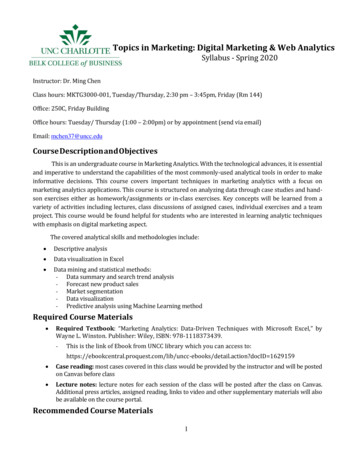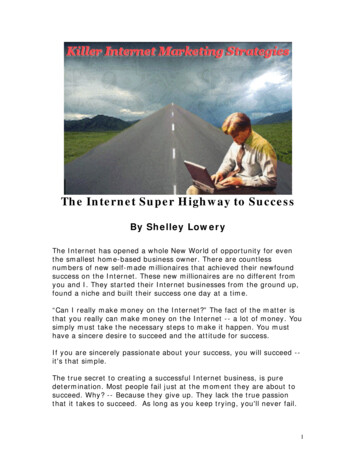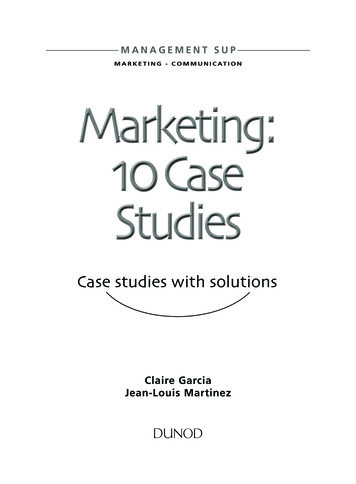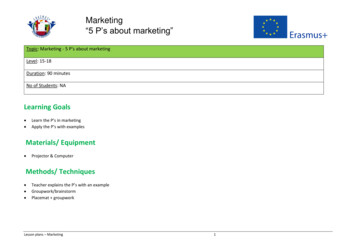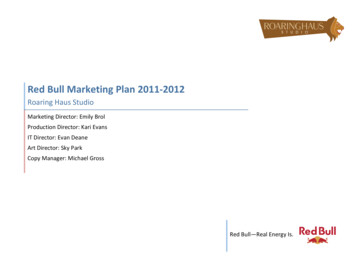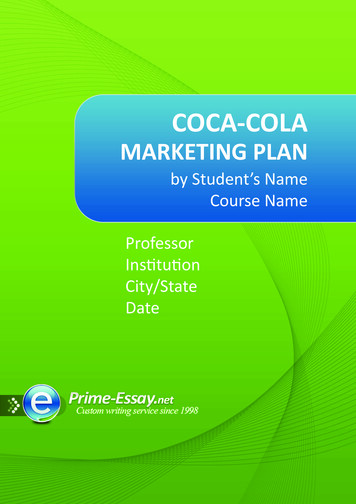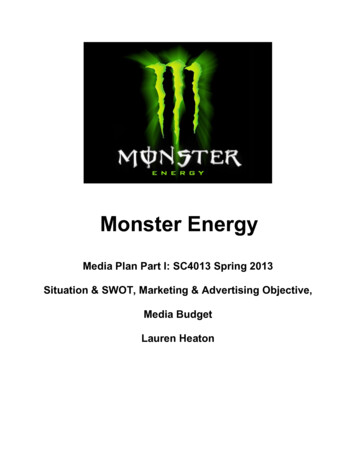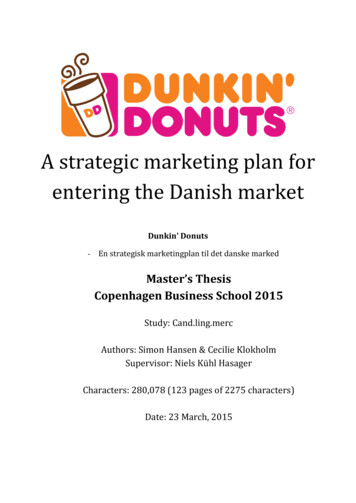
Transcription
Mothercare Marketing Plan
TABLE OF CONTENTSExecutive Summary . . . 1Section 1: Introduction . . . 21.1 The Company . . . 21.2 The Innovative Business Idea . . . .2Section 2: The SOSTAC Planning Framework . . 3Section 3: First Stage: Situational Analysis . . 43.1 External marketing Audit . 43.2 Internal Marketing Audit . . 63.3 SWOT Analysis . 9Section 4: Second Stage: Objectives . . 104.1 Mission Statement . 104.2 Objectives . 10Section 5: Third Stage: Strategy . . 115.1 Mothercare’s Present Strategy . 115.3 Mothercare 360 Campaign: The Proposed Strategy . 125.3 Application of Ansoff Matrix . 125.4 The STP Process . 13Section 6: Fourth Stage: Tactics . 156.1 The Marketing Mix . . . 15Section 7: Fifth Stage: Action Plan . 18Section 8: Sixth Stage: Control and Implementation . 208.1 Balanced Scorecard Approach . . 208.2 Operational Strategy and Issues . 228.3 Integration of Marketing and Operations . 248.4 Risk Assessment and Recommendations . 268.41 Maintenance of a Healthy and Safe Environment . 27Section 9: Conclusion . . 292
Appendices . 30References . . 353
EXECUTIVE SUMMARYIn the 21st century, women have become more health conscious and are continuously finding ways tolook smart, trendy, slim and maintain their figure. However, most women who are expecting a childor who already have children have difficulty in maintaining the same beautiful shape they once had.The specialist brand retailer, Mothercare, has been around for more than 40 years and has alwaysdelivered on its promise of caring for women every step of the way. Now Mothercare wants to keepits binding promise and lend a helping hand. The senior management had assigned a marketing andoperations team to develop the ‘Mothercare 360 Campaign’ for keeping women of all ages in tip topshape by offering them the best professional advice and care available at the new Mothercarewomen’s gym, opening in April 2011.The project report for delivering the Mothercare 360 Campaign has the following nine sections: Section 1 gives a brief introduction to Mothercare Plc. Section 2 gives a brief description of the SOSTAC model which is divided into six stages andwill be applied in this project report to create an effective marketing campaign. Section 3 presents an environmental analysis using PEST, Porter’s five forces and SWOTmodels. Section 4 defines the marketing objectives of the campaign. Section 5 defines the marketing strategy of the campaign which will accomplish the setobjectives. Section 6 defines the marketing tactics in the form of the Marketing Mix. Section 7 gives a detailed outline of the action plan to be achieved using a Gantt chart and abudget analysis. Section 8 discusses the control and implementation phase, contingency planning, integration ofmarketing and operations and risk assessment. Section 9 concludes this project report.1
SECTION 1INTRODUCTION1.1 THE COMPANYFounded in 1961, Mothercare is a specialist retailer of parenting and children’s products. Thecompany offers maternity and children’s clothing, furniture and home furnishings, bedding,feeding-, bathing- and travel equipment and toys (Datamonitor 2010).Mothercare has more than a 1000 stores across the globe. The company recorded a substantialincrease in revenue; 723.6 million in the financial year ending March 2009 and worldwidenetwork sales up to 1.1 billion by April 2010 (Datamonitor 2010). Appendix A gives aconsolidated view of Mothercare’s financial statements.Headquartered in the United Kingdom, where Mothercare displayed weaker sales in first quarter of2010, the company has expanded its operations in Europe, Middle East, Africa and the Far East.Mothercare’s major competitors include Jacques Vert, the Marks and Spencer Group, Monsoon,Moss Bros Group, NEXT, Alexon Group PLC and Toys R Us LimitedIan PeacockChairman, Mothercare PlcSource: Mothercare (2010) and (Datamonitor 2010).1.2 THE INOVATIVE BUSINESS IDEA‘The Expansion of the Mothercare Group into the UK’s Health and Fitnessindustry by opening a new gym for women of all ages’2
SECTION 2THE SOSTAC PLANNING FRAMEWORKBusinesses typically either thrive in their market or simply fail. The difference between a businessthat thrives and one that fails is often the marketing plan that is created and used (Chaffey et al.,2005). Though various marketing plans have proven effective over the years, many experiencedbusiness consultants claim that the SOSTAC model is one of the most effective (Smith and Taylor2004).Created by Paul Russell Smith, the SOSTAC planning framework is one of the most powerfulplanning systems ever developed. It is extremely effective as it contains the six vital ingredientsfor the perfect marketing plan (Fig. 2).Fig.2PR SMITH’S SOSTAC PLANNING FRAMEWORKSSITUATIONAL ANALYSISOOBJECTIVESSSTRATEGYTWhere are we now?STAGE 1Where do we want to go?STAGE 2How do we get there?STAGE 3TACTICSWhat tools do we use to implementthe strategy?STAGE 4AACTION PLANDetailed Action Plan for each tooland tactic.STAGE 5CCONTROLTracking our progress by measuring,monitoring,reviewing, modifying and updatingSTAGE 6Source : Smith (2003)3
SECTION 3FIRST STAGE: SITUATIONAL ANALYSISIf an organisation wants to expand into a different type of industry or business setting, it is of vitalimportance for the organisation to conduct a situational analysis in order to keep up with thechanging environmental trends and to strengthen the foundation of their strategies (IDM Firm2007).A Situational or Environmental Analysis can be defined as a problem-definition frameworkdesigned for the systematic collection of past and present data to examine the trends, forces,internal factors and external factors which have a potential to influence the performance of thebusiness (AMA 2007).The first stage of the SOSTAC planning framework, Situational Analysis is undertaken by theapplication of PEST Analysis, Porter’s Five Forces and SWOT Analysis.3.1 EXTERNAL MARKETING AUDITTo examine Mothercare’s external market, the macro-environmental model called the PESTanalysis was used to study the political, economic, social factors and the technological climate.Figure 3.0 gives an illustration of Mothercare’s external environment using the PEST model.4
Figure 3.0PEST ANALYSIS OF MOTHERCARE (EXTERNAL)ECONOMICPOLITICAL General ElectionsThe political importance of parents with babies andyoung children is underlined by the ‘Mumsnetelection’ in May 2010. Ethical Trading and SuppliersMothercare sources products from around theworld and has a code of practice on the EthicalTrading Initiative’s Base Code. All suppliers shareits values and are committed to working towardscompliance with its Code. Environmental policyMothercare is fully committed to protecting itscustomers, people making its products and theenvironment by ensuring efficient use of rawmaterials, optimising the use of energy,encouraging recycling and sustainability, andengaging business partners and stakeholder groups. Corporate Social ResponsibilityThe European government has refused to takeaction on a controversial chemical (BPA), widelyused in babies’ bottles, which could lead to serioushealth issues. Mothercare will be stopping itssupply of older bottles this August.TECHNOLOGICAL Internet Shopping ConvenienceMothercare offers their consumers to shop andhave their goods delivered home using informationtechnology Social Networking WebsitesThe Mothercare group has appointed Diffusionwith developing a social media strategy to targetparents online and offline. The company is also onFacebook and Twitter where B2C interaction ishigh and the company can hear what customershave to say about their products and services.21st Century RetailerUse of laser scanners at cash tills and energyefficient products suited for the modern user. Sources : Mcare (2010), Keynote (2009), Taylor (2010),BBC News (2010), BBC News 2 (2010), BBC News 3(2010), International (2010), BBC News 4 (2010), BBCNews 5 (2010), National Statistics Office (2010), Expat(2009) UK Economic GrowthThe UK economy grew by a faster-than-expected 1.1%in the second quarter of 2010. The UK economy hascome out of recession, after figures showed it hadgrown by a weaker-than-expected 0.1% in the last threemonths of 2009. UK Inflation Rate and IndexesUK inflation slowed for a second consecutive month inJune, to 3.2% from 3.4% in May. The Retail PricesIndex (RPI) inflation measure also fell to 5% from5.1% in May Unemployment RateThe number of people employed increased by 184,000.The number of people unemployed in the UK fell by49,000 to 2.46 million in the three months to June2010. International EconomiesMothercare's overseas franchise business currentlyoperates through 358 stores in 45 countries, primarilyin Europe, the Middle East and the Far East.SOCIAL Marketing Baby ProductsMany social and demographic factors have a stronginfluence on the market for baby products. Theseinclude: falling birth rates, smaller family sizes and theuse of efficient mobility products for longer journeys. UK DemographicsThe UK population grew to 61.8 million in 2010. Therewere 791,000 babies born in 2008, an increase of33,000 on 2007. By 2034, 23 per cent of the populationis projected to be aged 65 and over. UK Firms and CharitiesFirms such as Pearson, Serco and Tribal line up to runfree schools. Mothercare’s principle vehicle fordonations and charity is the Mothercare GroupFoundation UK Living CostsThe cost of living differs depending the person’slifestyle and location. Some provinces and countrysideareas can offer cheap and very affordable livingconditions. London is one of the global commercialand business centres. Living in this major city isdefinitely expensive when compared with smallertowns in the United Kingdom5
3.2 INTERNAL MARKETING AUDITThe IIA and CIPFA maintain that an internal audit of an organisation has an independent assurancefunction and consulting activity which is designed to add value and improve an organisation’soperations. It helps an organisation to accomplish its objectives by examining, evaluating andreporting, and bringing a systematic, disciplined approach to improving the effectiveness of riskmanagement, economic control and the effective use of resources (CIPFA and IIA 2007).For conducting an extensive internal marketing audit, the use of the 6Ms model – men, machinery,money, minutes, material and markets – could be used, but for the purpose of this project report,the internal market of Mothercare will be examined by using Porter’s five forces model.The Porter’s five forces model was developed by Professor Michael Porter in 1980. His frameworkfor industry analysis and business strategy development is a micro-environmental model which isused for identifying an organisation’s competitiveness helping firms to increase their potential bybeing aware of its competitors (Sloman and Sutcliffe 2004).In simple terms, the Porter’s model is a powerful tool for understanding where power lies in abusiness situation. This is useful because it helps one to understand both the strengths of thecurrent competitive position and the strengths of a position one is looking to move into (Mindtools 2007).6
Fig. 3.1MICRO-ECONOMIC APPLICATION OF PORTER’S 5FORCES MODEL TO MOTHERCARE (INTERNAL)ForceIssuesMothercare faces intensecompetition from nine maincompetitors, as listed below.Competitive RivalryImpact on Mothercare GymNegative, as the introduction ofthe Mothercare gym willincrease competition in themarket.Jacques VertMarks and Spencer GroupMonsoonMoss Bros GroupNEXTSeven Arts PicturesAlexon Group PLCHamleys of LondonToys R Us LimitedMothercare faces severecompetition on the price andquality of its products from theabove competitors.Positive, as Mothercare willneed to try harder to attract andretain customers but will offeran additional service not beingoffered by its majorcompetitors.Opening a gym involves highcapital requirements.Negative, as Mothercare needsto invest a lot of capital to startthe new venture.Opening a gym involves a verysubstantial financial investmentfor Mothercare.Negative, as Mothercare needsto invest a lot of financialinvestment to start the newventure.Threat of New EntryThreat of SubstitutionThere are high switching costs ascustomers have a great variety tochoose fromConsumer awareness of price andprovision of quality of productand services.Negative, as Mothercare willneed to continuously monitor itsproduct and service rangeNegative, as high consumerawareness increasesMothercare’s competitivenessand it will always have toprovide the best products andi7
ContinuedThere are large switching costs as buyerswill only buy the best products andservice that satisfies their need.Buyer PowerBargaining power of buyers is high dueto its well-known reputation and positionin the UK market.Mothercare will need to purchase a widerange of goods from suppliers to open upthe gymnasium, eg. gym equipment; alsoproducing marketing materials.Negative, as Mothercare willneed to provide customers withsomething innovative anddifferent that satisfies customersneeds better than itscompetitors.Positive. Buyers will conduct amarket survey and then decidewhich they feel is the bestchoice to satisfy their needs.Positive, as Mothercare willneed to negotiate p
that thrives and one that fails is often the marketing plan that is created and used (Chaffey et al., 2005). Though various marketing plans have proven effective over the years, many experienced business consultants claim that the SOSTAC model is one of the most effective (Smith and Taylor 2004). Created by Paul Russell Smith, the SOSTAC planning framework is one of the most powerful planning .


